Electricity is an immensely more powerful force than gravity, and far more complex in the ways it interacts with matter. Yet modern astronomy remains wedded to a belief in gravity as the dominant mover and shaper of the universe, and seeks to explain new observations in terms that conceptually go back hundreds of years. James Hogan describes an emerging alternative theory that recognizes the important role played by electricity on cosmic scales, offering explanations based on principles that are well understood and demonstrable in laboratories, without need of recourse to unobserved, untestable physics or speculative mathematical abstractions.
Humans have a wonderful ability for creating visions of ways to improve themselves, thereby making the world a better place; and then, it seems, for losing track somewhere along the way of turning the visions into reality.
Take the business of science, for instance. After several thousand futile years of fighting wars over whose revealed truth was really true, and attempts to impose truth by decree with the aid of rack and thumbscrew or deduce it via rigorous logic from self-evident premises that nobody could agree on, the idea finally emerged that a better way of finding out about the way things are in the world might be to stop fixating on how they ought to be, actually look at what's out there, and accept what it's telling you, whether you like it or not. It works pretty well with such questions as figuring out why cannon balls and planets move the way they do, what heat is, and other matters that can be decided beyond argument according to whether your motor starts or not, or if your plane gets off the ground – all of which rapidly become engineering. But when it comes to issues that aren't settled so easily – the meaning and origin of life; how the cosmos gets to be the way it is, and where it came from: areas where authority can still command and get away with it – things don't seem to have really changed that much. Powerful establishments enjoying political favor and monopoly privileges in teaching and promotion rigidify into orthodoxies defending their beliefs tenaciously, with dissenting views being dismissed, ridiculed, and marginalized, even when supported by what would appear to be verifiable fact and simpler arguments. In possibly an ultimate of ironies, in areas where hopes for science were at their highest, instead of showing the openness to alternatives and readiness to follow the evidence wherever it pointed that were supposed to characterize the new way of understanding the world, much of what we hear today seems to be taking on more the trappings of intolerant religion protecting dogma and putting down heresy.
More than ninety-nine percent of the observed universe exists in the form of matter known as plasma. In the atoms that make up the planet we live on, equal amounts of positive and negative electric charge are confined together and cancel each other out, resulting in objects like rocks and cabbages that are neutral on balance and hence "feel" only the force of gravity. Plasma, by contrast, consists, fully or in part, of charged particles – negative "electrons" and positive "ions" (an atom missing one or more of its electrons) – that are separated, and hence respond to electric and magnetic forces. The electric force between two charged particles, which can be attractive or repulsive, is thirty-nine orders of magnitude stronger than the gravitational attraction between them. That's a one followed by 39 zeros. Such a number boggles the imagination. It is in the order of a millionth of a millimeter compared to 10,000 times the size of the known universe. Even in a plasma comprising just one charged particle in 10,000 – which would be typical of the interstellar clouds of dust and gas from which stars are formed – electromagnetic forces will dominate gravity by a factor of ten million to one. Yet, conceptually, the prevailing view of the cosmos remains essentially rooted in the work of such names as Kepler, Newton, and Laplace, whose laws describe a mechanical universe made up of neutral bodies moving in a vacuum under the influence of gravity. And today's reigning cosmological model, founded on general relativity, is essentially a theory of geometry manifesting itself as gravity.
Gravity-based models were reasonable two hundred and more years ago, when Newtonian dynamics was shown to predict precisely the motions of the Solar System. The plasma that permeates interplanetary space was unknown, along with its ability to organize spontaneously into isolating sheaths that, under stable and tranquil conditions like those prevailing in our locality at the present time, screen planets from electrical forces. And not a lot was understood about electricity in any case. But more recent advances in observational astronomy have revealed phenomena that do not lend themselves readily to explanation in familiar gravitational terms. Pulsars – rapidly varying stellar objects conventionally interpreted as spinning neutron stars – have now been measured to fluctuate at rates that call into question even the power of postulated neutron matter to hold together. Quasars, if accepted in accordance with the customary reading of red-shift as being the most distant objects known, radiate energy with intensities that defy explanation by any process involving conventional matter. The way galaxies rotate, and their violent ejections of matter jets, do not conform to expectations based on gravity. To account for these and other anomalies, such speculative devices as "dark matter" – at the last count numbering seven different varieties – "dark energy," matter collapsing into black holes, and similar exotic mechanisms that have never been observed are introduced to make the theory fit the facts.
Seeking to explain new findings in familiar terms is natural and represents a desirable economy of thought. Models that have become standard were not lightly arrived at and should not lightly be cast aside. However, as was seen with the ever-more elaborate systems of epicycles contrived to keep the Ptolemaic system alive for long after a change of thinking was called for, such conservatism can be taken too far. There comes a point where, "We don't need another theory, because the one we've got can be made to fit the data," is saying more about human inventive ingenuity than the accuracy of the theory.
Over the last two hundred years an enormous amount has been learned about electricity. Technology has gone from Faraday motors and hand-cranked Wimhurst machines to super computers and satellite communications. In parallel with these advances, electrical theorists have developed an alternative paradigm for interpreting astronomical observations, based on principles that are well understood and can be demonstrated in any electrical or plasma laboratory. It requires none of the esoteric physics or ad-hoc inventions that the mainstream has had to resort to repeatedly when new observations failed to match expectations, or were never anticipated at all, and it is proving to be more powerful predictively. Proponents refer to it as Electric Universe theory. Its basic premise is that what we're seeing when we point telescopes at new stars being born or violently energetic events deforming distant galaxies are not results of gravity being intensified unimaginably and behaving in strange and unheard of ways, but electricity. Where electrical forces are operating, gravity effectively ceases to exist. A tiny magnet will snap a nail up effortlessly against the gravitational pull of the entire Earth. You don't have to keep your coffee pot below the wall outlet to enable the electrons to fall down through the cord.
Around the turn of the nineteenth century, the Norwegian physicist Kristian Birkeland studied the northern auroras and concluded that they are caused by charged particles from the Sun being directed to the polar regions by the Earth's magnetic field, where they excite atoms of the upper atmosphere to light-emission energies. This was not favorably received by the theoreticians of his day, whose mathematical models treated the Earth as an isolated object in space, and his work was largely ignored. Although satellite measurements have since confirmed the existence of interplanetary plasma and Earth's complex environment of fields, particles, and currents, there is still an entrenched reluctance to accept them as parts of electrical circuitry that not only connects the Earth to the Sun, but spans the entire Solar System.
Recognition of space as pervaded by plasma, and hence able to conduct electric currents, is what distinguishes the electrical model of the universe. Electric currents create magnetic fields, which induce secondary currents, which in turn produce their own fields. The complex interplays of forces that result can give rise to amazingly intricate structures and behaviors of matter. Currents in plasma flow as elongated filaments, which can be visible in instances like auroral displays and lightning, where energies become high enough to initiate electrical discharge. Parallel filaments are pulled together in an effect known as a "pinch," which can be very powerful. At shorter ranges, however, the net force between the filaments becomes repulsive rather than attractive, causing them to rotate and twist around each other into a braided structure as they approach, instead of merging. The braid can interact with similar braids to form "ropes" on a larger scale, which might then repeat the process.
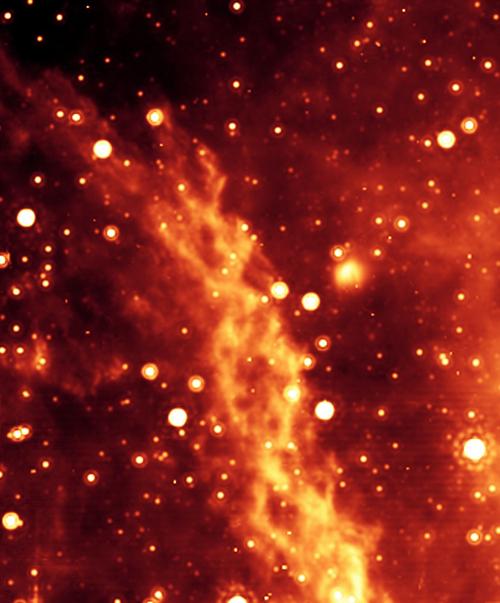
Electric currents
in space. The Double Helix nebula, located near our own
galactic center.
Such braided structures are the signature of electric currents in plasmas. They have been shown to scale up through an astonishing fourteen orders of magnitude. Effects produced on a microscopic scale in laboratories can be observed unfolding at cosmological dimensions.
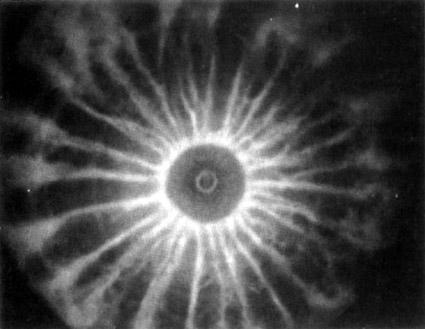
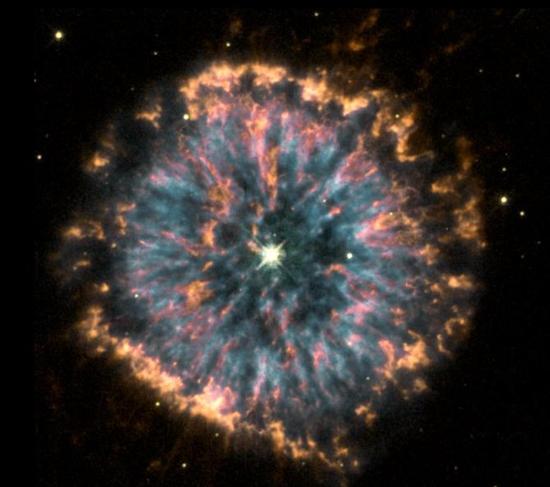
Sub-millimeter-size
tornadoes of current produced by the Plasma Focus, a fusion research
device, compared to a Hubble image of the planetary nebula NGC
6751
The standard model of star formation has stars condensing from an accretion disk of dust and gas as it contracts under self-gravitation. It has remained essentially unchanged for two hundred years despite having a number of problems. For a start, simulations and calculation indicate that peripheral matter in such a disk would disperse rather than coalesce into planetary clumps. Then there's the question of how the angular momentum – the property that makes a flywheel want to keep turning – comes to be concentrated in the planets – 98 percent of it in the case of our Solar System. A contracting disk should deliver most of its angular momentum to the central part, giving the Sun a rotation period of something like 13 hours instead of the 28 days that it has. And further, where did it all came from to begin with? Dispersed matter initially moving randomly should contain very little net angular momentum. Finally, for a star the size of the Sun, gravitational contraction won't produce a high enough density at the core to generate the temperature necessary for igniting the fusion reactions generally believed to be the power source. To make it work, various quantum mechanical improbabilities are wheeled in to allow things to happen that all the odds say shouldn't.
Stars are concentrated along the spiral arms of galaxies, which is also where new stars come into existence. The electric model proposes the arms to be the paths of currents traversing the galactic disk, and stars as the focal points of pinches occurring between them, strung like beads on threads. Electrical forces offer a far more effective means than gravity for gathering, compressing, and heating dispersed material. And, from what was said earlier, rotation is no longer an anomaly in need of explanation, but imparted naturally as a result of the process. Here's an example of where you can see it happening.
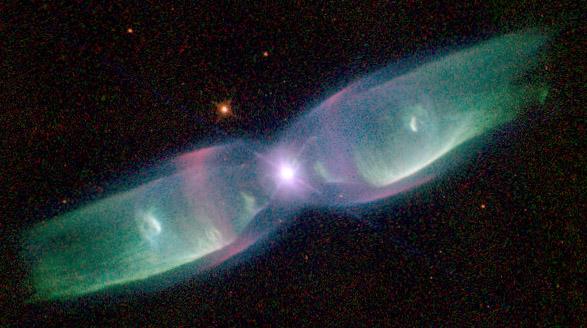
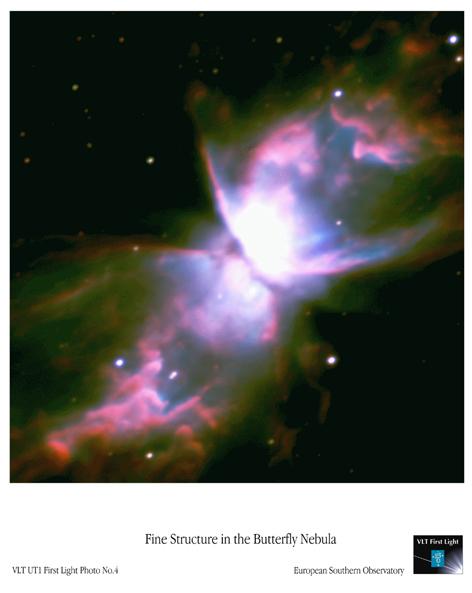
The
Butterfly nebula. Embedded current cylinders converging and producing
plasma glow discharge over a distance greater than the diameter of our
Solar System. The close-up of the neck shows a dusty toroid occluding the
central star. The physics of plasmas predicts such a
torus.
On a larger scale, the same process explains galaxies. Electric galaxies were first proposed by the Swedish Nobel laureate Hannes Alfvén in the middle of the last century, who envisioned immense rivers of electricity flowing through space, of intergalactic extent.
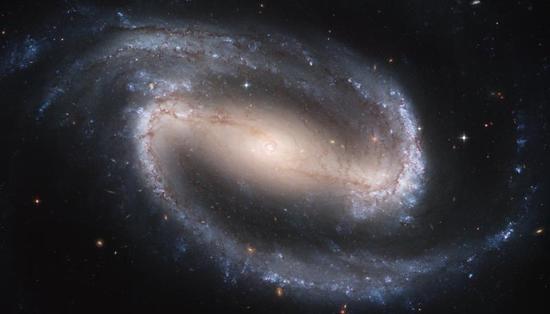
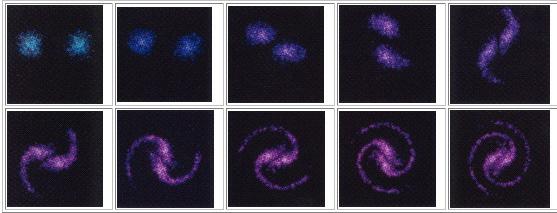
Sequence from a
supercomputer simulation at Los Alamos National Laboratories of the
structure arising from a pinch between two plasma currents. Above, a real
galaxy for comparison.
Galaxies don't rotate in the way that predictions from gravity-based cosmology say they should. With the amount of observed mass and the velocities measured at the rim, they ought to be flying apart. The solution of choice is to invoke "dark matter," never actually observed, but which can be given just the right properties and put in just the right places to produce the desired results. It has been called "cosmic duct tape" – capable of fixing anything. By contrast, the electric model holds that, far from being isolated, passive accumulations of mass revolving under their own momentum after being spun up by some unexplained cause, galaxies are active components in enormous cosmic power circuits. They're not flywheels, but motors, driven by forces easily able to hold them together without need of invisible glue. Inventing unobservables to hold up failed predictions is usually the sign of a theory in trouble.
Galaxies are not distributed evenly through space, but concentrated in strings and "walls" around voids that can be thousands of light-years across. According to the standard theory, structures of that size shouldn't have had time to form in the 14 billion years since everything was supposed to have started with the Big Bang. But it's what would be expected if galaxies result from cosmic electric currents, because currents flow in filaments and sheets of filaments – the veils of the polar auroras, for example. The cosmology developed by Alfvén and his intellectual descendants proposes an earlier plasma epoch in the evolution of the cosmos, in which electromagnetic forces played the initial role of collecting matter together to create the densities that enabled gravity to become a significant factor only later, making the 14 billion years no longer an issue.
Many galaxies are found to be shooting out enormous jets of matter and energy in the direction of their axes, often on scales that dwarf the galaxy itself. The rotating system of currents converging on the axis, along with its associated magnetic fields, stores enormous amounts of energy. Releases due to instabilities or the need to shed excess from an accumulating buildup would manifest themselves in just this kind of way.
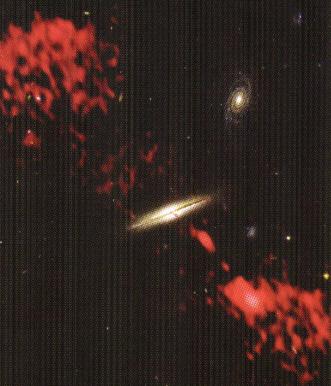
Radio Galaxy 1313-192. Jets emitted by the visible galaxy power the x-ray
emitting lobes. Such lobes were predicted by Hannes Alfvén long before
radio sources were discovered.
A gravitational explanation of such energies requires postulating black holes to concentrate to almost infinite density the weakest force known to physics, and the creation of jets through unclear processes involving acceleration and mechanical collisions in accretion disks of matter spiraling into them. Despite widely repeated claims to the contrary, black holes have never been observed. What is observed are enormously energetic events occurring in space. Attributing them to black holes is part of the assumed basis for interpretation. The way engineers and researchers produce x-rays is by accelerating charged particles with electric fields. Your dentist doesn't do it by banging rocks together.
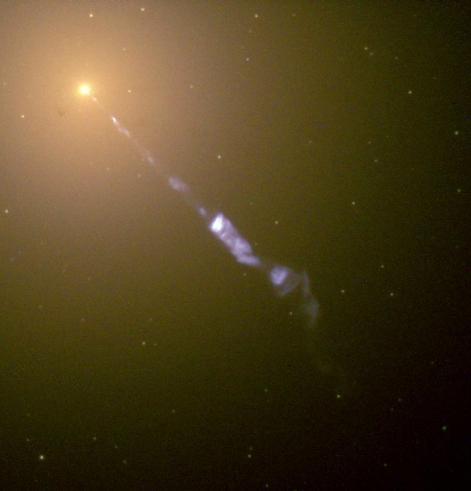
Jet
emerging from galaxy M87 extends for thousands of light-years.
Electrical structures remain coherent over such distances, whereas neutral
gas would rapidly disperse. The glow is consistent with electrically
accelerated electrons spiraling along magnetic
field lines.
The term "plasma" was co-opted from biology in recognition of the eerily lifelike forms and changes observed in electrical discharge experiments with ionized gases. Besides forming filaments, braids, sheets, and isolating layers, plasmas will organize into cellular structures bounding regions possessing different properties such as temperature, density, and chemistry. The Cat's Eye nebula shows the kind of complexity that can result.
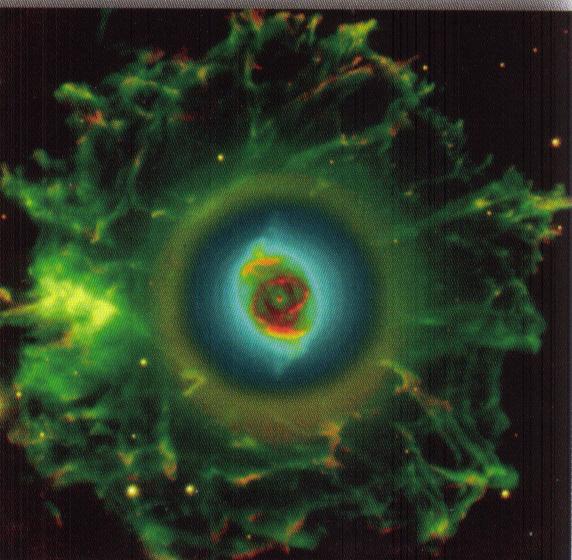
And this is the core region, with the star at its center.
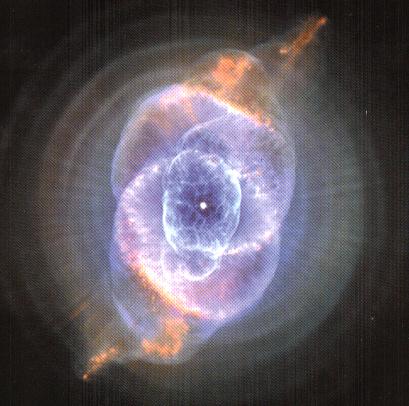
So what are we seeing? Gravity, which produces formless coagulations of matter like clots in cream? Or electricity?
Some suggested web sites for further information on the Electric Universe:
- saturniancosmology.org
- www.holoscience.com
- www.thunderbolts.info
- www.plasmaresources.com
- http://public.lanl.gov/alp/plasma/TheUniverse.html
- [http://www.electric-cosmos.org/indexOLD.htm]
July 30, 2008
James P. Hogan [james at jamesphogan.com], a former digital systems engineer and computer sales executive, has been a full-time writer since 1980. He was born in London, moved to the USA for many years, and now lives in the Republic of Ireland. His web site was at www.jamesphogan.com.
Copyright © 2008 LewRockwell.com